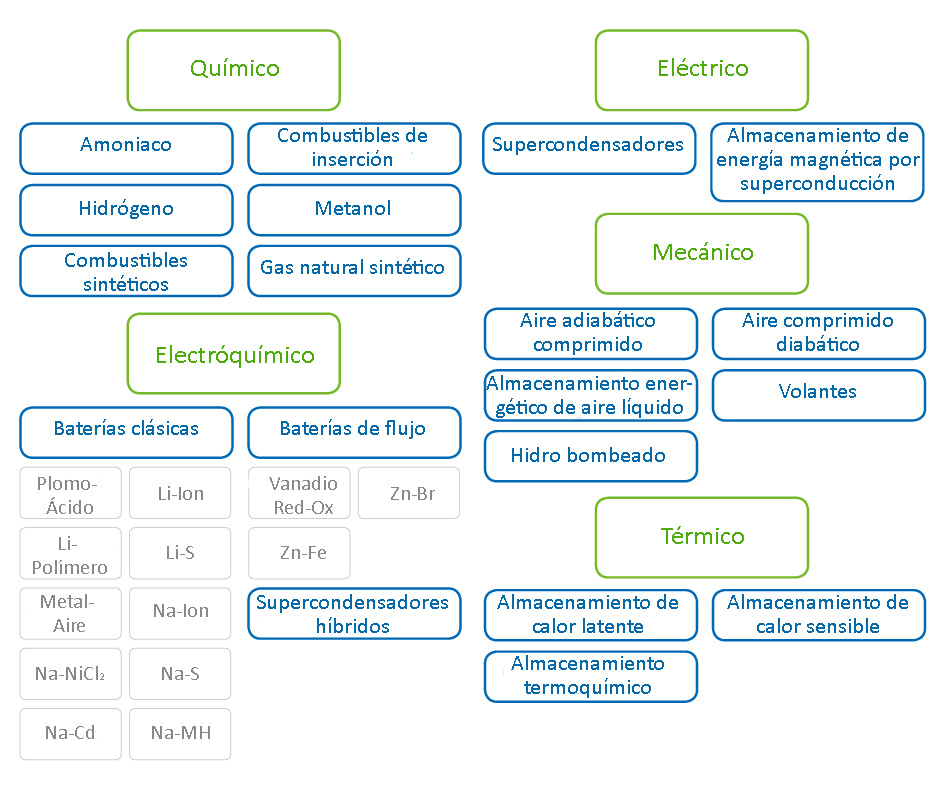admin | 22/01/2020
Large-scale industrial energy storage systems have proven to be an integral tool for energy companies and the ideal solution for guaranteeing reliable electricity supply to the global population, while at the same time advancing in a decarbonized economy model with the integration of variable renewable energy sources.
With a nearly twofold increase compared to the 2017 level, installation of energy storage systems reached a record level in 2018 of over 8 GWh. Although there are countries such as South Korea, China, the United States, and Germany that are leading the way in the implementation of these plants, the global commitment is apparent and “new markets have emerged quickly in places where governments and energy companies have created support mechanisms, including Southeast Asia and South Africa, which indicates a need for support policies,” specified Miguel Santos and Jorge Nájera, researchers from the Electrical Power Systems Unit at the Center for Energy, Environment, and Technology Research (CIEMAT).
In effect, energy storage facilities require government aid and an established market framework. That, together with the constant decrease in storage technology costs and the increase in the manufacture of batteries for electric vehicles, would give a boost to the sector. Such is the case, that the Bain & Company report, Embracing the Energy Revolution: Electricity Storage, estimates that large-scale energy storage systems could be cost competitive with peaking plants in 2025.
Storage technologies
Today, there is a wide variety of energy storage technology, depending on how it is stored, as explained by the CIEMAT researchers:

– Chemical storage. This is the case with hydrogen, which is obtained from water electrolysis. This type of energy is stored as H2, or hydrogen derivatives such as fuels or hydrides, which can then be “burned” in fuel cells to produce new electricity.
– Electrochemical storage. Conventional batteries (alkaline, lead-acid, lithium-ion, etc.) or flow batteries.
– Electrical storage. Energy is stored in electrical or magnetic fields in super condensers or superconductor spools, respectively, which enables a quick response of power, with reduced long-term storage capacity, however.
– Mechanical storage. Includes compressed air, liquid air, flywheels, and pumped-storage power.
– Thermal storage. Storage in molten salts, which is frequently used at thermal solar plants.
The vast majority of installed power (99%) is represented by pumped-storage, while the remaining 1% is a combination of the other technologies, particularly compressed air and various battery types. However, in recent years, lithium batteries have contributed notably to the annual installed power capacity. “Energy storage technologies are characterized by their capacity, power, energy, and discharge time. There is no single option that is ideal globally, rather each one offers optimal benefits under different power conditions and discharge times,” Nájera and Santos asserted. They are, therefore, complementary technologies; “hybridization—in other words, a combination of various storage technologies—is the optimal solution in the majority of real-world problems.
Integrating Renewable Energy
Energy storage systems are also positioned as key players for use with renewable energy as, according to CIEMAT experts, storage systems increase the share of renewable energy in ancillary services and grid regulation services, reduce spills, contribute to meeting demand, decrease renewable energy generation’s variability, ensure predicted energy production, reduce operating and generation costs, and, in short, provide greater security and reliability to the electrical system.
At the industrial level, the most used combinations of variable renewable energy and storage are:
– Wind energy + batteries/hydrogen. To date, the most used batteries are Li-Ion. Although flow batteries have also been installed with considerable success. The option with the greatest future is known as “power-to-gas,” which uses hydrogen for storage.
– Photovoltaic solar energy + batteries. Lead-acid batteries have traditionally been used. Recently, however, Li-Ion batteries are becoming widespread in the market.
– Thermal solar energy + salts. To date, the most used salts have been liquid salt mixtures of sodium nitrate and potassium.
In any case, variable renewable energies have three main characteristics that make integration with the electrical grid difficult: variable production, uncertain prediction, and remote locations. Therefore, increasing this energy type’s penetration percentage requires an increase in system flexibility to keep these characteristics from becoming problematic for the delivered energy’s reliability and quality of.
Flexibility of the Energy System
There is also an environmental problem that must be addressed, considering that extracting and manufacturing materials to produce the storage systems entails a significant energy cost that can at times produce extreme contamination (lithium mining).
In 2014, the International Energy Agency published a roadmap identifying energy storage as a key element in reaching the global decarbonization objectives. It was then estimated that approximately 310 GW of additional storage connected to the grid would be required to reach that goal. Vital actions were also identified, including the design of a regulatory framework and a market to accelerate the sector’s development and investment in R&D and demonstration projects.

Source: Tracking Energy Integration, by the International Energy Agency
In this regard, the World Bank recently established an agreement committing ]
billion to accelerate investments in battery storage for energy systems in middle to low income countries. This investment’s goal is to increase the use of wind and solar energy in developing countries, as well as to improve the energy stability, quality, and grid reliability, while reducing carbon dioxide emissions.
Energy Storage Technologies

Source: European Association for Storage of Energy
Article collaborators…
 Jorge Nájera is an industrial engineer specializing in Electrical Engineering from the Polytechnic University of Madrid, where he has begun his doctoral studies.
Jorge Nájera is an industrial engineer specializing in Electrical Engineering from the Polytechnic University of Madrid, where he has begun his doctoral studies.
He is an expert in modeling medium- and low-voltage electrical grids, bidirectional inverters, load controllers, and Li-Ion batteries. He also has extensive laboratory experience in programming and operating bidirectional charging stations for batteries and super condensers. His experience has enabled him to work on Spanish electric car projects such as SEGVAUTO-TRIES-CM and PCB Bus. He has experience at Elecnor as a technical advisor in the energy department.
At present, he is a researcher at the CIEMAT Electric Power Systems Unit, working on the European Union Seatitan project.
 Miguel Santos
Miguel Santos
is an industrial engineer, specializing in Energy, from the University of Valladolid. He also has a Master’s degree in Renewable Energy and Energy Market from the EOI Business School and a Master’s degree in Maritime Renewable Energy from the University of Strathclyde.
He is an expert in analytical modeling of wave energy converters and in technical and economic evaluation of wave energy and sea current devices. He also has experience as a project manager through his four years of work for Spanish technology company Wedge Global, coordinating and participating in the Undigen and Undigen+ projects.
Between 2017 and 2019, he worked for the Policy and Innovation Group at the University of Edinburgh. Currently, he is a researcher at the CIEMAT Electric Power Systems Unit in Madrid.





